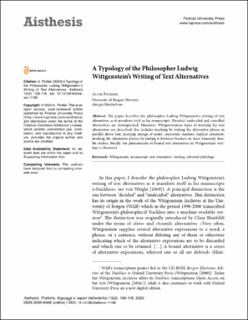| dc.contributor.author | Pichler, Alois | |
| dc.date.accessioned | 2021-06-29T13:12:14Z | |
| dc.date.available | 2021-06-29T13:12:14Z | |
| dc.date.created | 2020-12-07T15:15:20Z | |
| dc.date.issued | 2020 | |
| dc.Published | Aisthesis. 2020, 13 (2), 109-118. | |
| dc.identifier.issn | 2035-8466 | |
| dc.identifier.uri | https://hdl.handle.net/11250/2762380 | |
| dc.description.abstract | The paper describes the philosopher Ludwig Wittgenstein’s writing of text alternatives as it manifests itself in his manuscripts. Decided, undecided and cancelled alternatives are distinguished. Moreover, Wittgensteinian types of marking his text alternatives are described: this includes marking by writing the alternative phrase in parallel above line; marking change of order; separation markers; explicit comment; marking the alternative phrase by putting it between brackets or, most famously, double slashes. Finally, the phenomenon of bound text alternatives in Wittgenstein’s writings is discussed. | en_US |
| dc.language.iso | eng | en_US |
| dc.publisher | Firenze University Press | en_US |
| dc.relation.uri | https://oajournals.fupress.net/index.php/aisthesis/article/view/11166/11791 | |
| dc.rights | Navngivelse 4.0 Internasjonal | * |
| dc.rights.uri | http://creativecommons.org/licenses/by/4.0/deed.no | * |
| dc.title | A Typology of the Philosopher Ludwig Wittgenstein’s Writing of Text Alternatives | en_US |
| dc.type | Journal article | en_US |
| dc.type | Peer reviewed | en_US |
| dc.description.version | publishedVersion | en_US |
| dc.rights.holder | Copyright 2020 The Author | en_US |
| cristin.ispublished | true | |
| cristin.fulltext | original | |
| cristin.qualitycode | 1 | |
| dc.identifier.doi | https://doi.org/10.13128/Aisthesis-11166 | |
| dc.identifier.cristin | 1857053 | |
| dc.source.journal | Aisthesis | en_US |
| dc.source.40 | 13 | |
| dc.source.14 | 2 | |
| dc.source.pagenumber | 109-118 | en_US |
| dc.identifier.citation | Aisthesis. Pratiche, Linguaggi E Saperi dell’estetico. 2020, 13(2), 109-118 | en_US |
| dc.source.volume | 13 | en_US |
| dc.source.issue | 2 | en_US |

